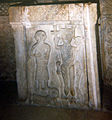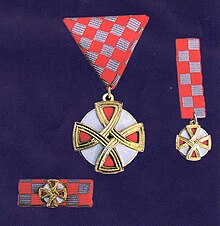Croatian wickerwork
The Croatian wickerwork ( Croatian Hrvatski pleter ) or Croatian three- cushion (Hrvatski troplet) is an old Croatian wickerwork ornament from the early Middle Ages . It is a knot pattern that was often combined with depictions of animals and plants and is often found as a frieze within church and monastery buildings from the 9th to 12th centuries. During this period of time, the wickerwork can be found in almost all stone works of art . The baptismal font of Prince Višeslav is particularly important . Croatian wickerwork is the Croatian national ornament and is still widely used today as an ornament .
Emergence
It was probably created by adopting and enriching elements of early Christian decorative art, with new wickerwork motifs from the original home of the Croats . This enriched decoration is said to have spread from Croatia , via Istria to Friuli and eastern Lombardy .
distribution
The wickerwork is found on works of art throughout the ethnic area of the Croatians . Most of the examples can be found in the Knin area , in the localities of Ždrapanj and Žavić near Bribir , in Rižnice near Solin , in Split and in Zadar .
gallery
Relief from Split
Inscription of King Stjepan Držislav
Relief, probably depicting King Petar Krešimir IV
Wickerwork in the emblem of the Croatian Armed Forces
See also
Web links
Individual evidence
- ↑ a b Mirko Šeper: The baptismal font of the Croatian prince Višeslav from the early Middle Ages . Self-published by the German Institute for Merovingian-Carolingian Art Research in Erlangen, 1958, p. 3 .
- ^ Josef Strzygowski: Research on the development of old Croatian art . Vienna 1926; Croatian edition in: Starohrvatska umjetnost (Old Croatian Art). Zagreb 1927.
- ↑ Ćiro Truhelka: Starokršćanska arheologia ( Early Christian archeology). Zagreb 1931.
- ↑ PLETER - povijest uklesana ukomu. ( Memento from February 27, 2012 in the Internet archive ) RivaOn.hr - portal Srednjih škola Zadarske županije. HINA Zagreb. (Accessed on December 3, 2002)






